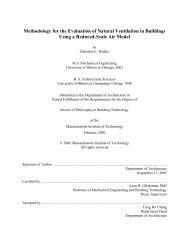CHT-08-012 Runchal_Final_Jun_08 - Cham
CHT-08-012 Runchal_Final_Jun_08 - Cham
CHT-08-012 Runchal_Final_Jun_08 - Cham
Create successful ePaper yourself
Turn your PDF publications into a flip-book with our unique Google optimized e-Paper software.
formulations that were being investigated. Another reason was the ease of interpretation of “ε”compared to other variables; it was simply equivalent to the energy dissipation near the wall. It wasduring this period that turbulence modeling became established as a practical tool. Spaldingworked extensively on turbulent flows for a while but then moved away to concentrate on otherfields of more immediate interest to him.William KaysDuring this decade, the Imperial College group haddistinguished visitors. These included J.C. Rotta(Goettingen), Frank Schmidt (Penn State), C-L Tien(Berkeley), William Kays (Stanford), Joseph Kestin(Brown), P.D. Richardson (Brown), Bill Reynolds(Stanford), Philip Saffman (Caltech), PeterBradshaw (NPL), David Pratt (Washington), LarryCaretto (Berkeley), Graham de Vahl Davis (NewSouth Wales), Tony Hirt (Los Alamos), HarryMcDonald (United Aircraft Res. Lab.), David Dyers(Alabama), and many others.Frank SchmidtLarry CarettoThese visits and interactions were very valuable indissemination of the IC CFD technology and itswide acceptance. Following a conversation withJim Whitelaw at the 1970 International HeatTransfer Conference in Paris, Frank Schmidtorganized a series of short courses at Penn Statethat were delivered by IC faculty and research staff.The courses started in 1972 and continued till 1994and covered a number of subjects includingcomputational methods for boundary layers, recirculatingflows, combustion and turbulence. Thesecourses were along the line of the 1969 Post-Experience Course at Imperial College and wereBill Reynoldsdirected at both academic and industrialcommunities. Frank Schmidt, Jim Whitelaw andBrian Launder also arranged a series of verysuccessful conferences on Turbulent Shear Flowsstarting in 1977 that in a modified form survive tothis day. Starting around 1970, Bill Reynolds and De Vahl DavisWilliam Kays were instrumental in arranging anumber of “Olympiads” where competing researchers presented the resultsfrom their computational methods for boundary layer flows and turbulence. The methods were thenformally “judged” in terms of agreement of the predictions with experimental data. These activitiesled to the IC CFD technology being widely known around the world.Tony Hirt ~1974ZienkiewiczThe IC group also interacted with Argyris andZienkiewicz about the merits of differentapproaches to CFD and their espousal of the Finite-Element (FE) method. Though we could see thatthere were some advantages to the use of FEmethod, the overwhelming feeling was that themethod was unsuitable for high-Reynolds numberflows and lacked clear theoretical basis (since theHamiltonian does not exist for non-linear systems).Argyris-- Page 10 of 19 --
















